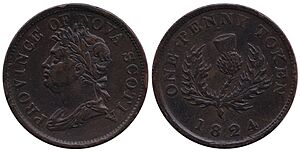Nova Scotian pound facts for kids

The pound (its symbol was £) was the money used in Nova Scotia for many years, up until 1860. It was a lot like the British pound. One pound was made up of 20 shillings, and each shilling was worth 12 pence.
In 1860, the pound was replaced by the Nova Scotian dollar. The exchange rate was set so that 5 dollars were equal to 1 pound. This meant 1 dollar was worth 4 shillings. Even though the dollar became the official money in 1860, the new dollar coins and banknotes didn't start being used until 1861.
Coins and Tokens
When the pound was the currency, people used both British coins and special local coins. These local coins were called copper tokens. They were made in 1823 and again in 1856. These tokens came in small amounts, like half a penny (½d) and one penny (1d).
Paper Money
Besides coins, paper money was also used in Nova Scotia.
Government Notes
In 1812, the government of Nova Scotia started printing its own paper money, called Treasury notes. These notes came in values like £1, £2½, £5, and £50. Between 1813 and 1830, they continued to print notes for £1, £2, and £5. Later, in 1830, they added smaller notes for 5 shillings (5/–) and 10 shillings (10/–).
Bank Notes
Two important banks in Nova Scotia also printed their own paper money. These were the Bank of Nova Scotia and the Halifax Banking Company.
The Halifax Banking Company began printing its notes in 1825. Their notes came in interesting amounts, such as £1½, £5, £6, £6½, and £7.
The Bank of Nova Scotia started printing its notes a bit later, in 1834. Their notes also had unique values, including £1½, £2, £2½, £5¼, £6, £7, £7½, and £10.
See also

